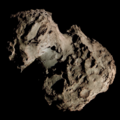 Infrared image of Comet Johnson taken by the Spitzer Space Telescope on 18 July 2005 | |
| Discovery [1] | |
|---|---|
| Discovered by | Ernest Leonard Johnson |
| Discovery date | 25 August 1949 |
| Designations | |
| P/1949 Q1, P/1956 P1 | |
| |
| Orbital characteristics [2] [3] | |
| Epoch | 28 April 2016 (JD 2457506.5) |
| Observation arc | 5,220 days (14.29 years) |
| Number of observations | 1,612 |
| Aphelion | 5.021 AU |
| Perihelion | 2.006 AU |
| Semi-major axis | 3.514 AU |
| Eccentricity | 0.42897 |
| Orbital period | 6.587 years |
| Inclination | 12.283° |
| 111.46° | |
| Argument of periapsis | 214.69° |
| Mean anomaly | 235.39° |
| Last perihelion | 2 March 2025 |
| Next perihelion | 2031-Sep-29 [4] |
| TJupiter | 2.931 |
| Earth MOID | 1.007 AU |
| Jupiter MOID | 0.513 AU |
| Physical characteristics [5] [6] | |
| Dimensions | 6.0 × 4.4 km (3.7 × 2.7 mi) |
Mean diameter | 5.74 km (3.57 mi) |
| 29 hours | |
| Comet total magnitude (M1) | 8.9 |
| Comet nuclear magnitude (M2) | 13.4 |
48P/Johnson is a periodic comet in the Solar System.
The comet nucleus is estimated to be 5.74 km (3.57 mi) in diameter by Lamy, Fernandez, and Weaver. [7] Meanwhile, David C. Jewitt and Scott S. Sheppard estimate the nucleus to have dimensions of 6.0 × 4.4 km (3.7 × 2.7 mi). [5]

